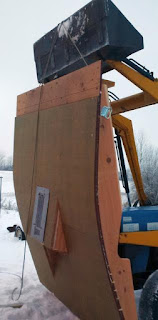December 2015 sailboat project update
So this year I have actually made some progress on building
something. It still takes a lot of imagination to see a sailboat, but trust me,
it will be.
Much of the work was in preparation, getting the barn ready
to work in. I fixed the heater so I would have thermostatic control of the heat
I have picked up stuff to go in
the boat, such as a cute little Hobbit wood stove http://salamanderstoves.com/product/small-stove-hobbit/?ap_id=npeterson,
which I bought before I discovered the Canadian made Cubic wood stoves

.
Yes, that is the composting toilet as well, both set up in
the barn.
Here is the motor and jet pump I am going to put in the
boat.

The original plan was an outboard in a well, but I had an
old Mercedes 240D with a rusted out body and a good 65 Hp diesel in it. I
thought I would use it and a marine transmission to a prop. The transmission
turned out to be a difficult thing to find on the prairies, so I thought a jet
pump would be a good idea, nothing to catch on the bottom. I found someone in Calgary
selling a 350 Oldsmobile marine engine and Berkley
jet pump, at a very good price, so I bought it. I was going to get the pump
modified to match the little diesel, then decided that since the motor and jet
pump was all ready to go, I would use it as is. I can always change it later,
and have designed the bottom opening so that I could remove motor and pump and
replace them with an suitable outboard, if I ever find one at a reasonable
price.
I welded a steel frame, to make a level work platform for
now, and it will eventually become a flatbed trailer for the boat.
Here is the last 8 feet of the boat hull, upside down,
showing the pump during a dry fit
next pictures are flipping it over and getting it ready to
attach to the rest of the hull bottom

About to be glued in place
The front stringers, the smeared glue was due to installing
the MDO on the stringers by myself, wet 5200 acts as a lubricant I found out.
The first bulkhead I
built, between the salon and bunk (sorry for the blurry picture)


The galley to saloon bulkhead, the bottom 8 inches are
hidden in this picture
The cockpit to galley bulkhead, leaning against previous
bulkheads ( there is a big U shaped cutout for the doorway)

This is the front hold to bunk bulkhead

I have other pictures, but these show a good overview of my
current progress. The next stage is adding the false floor, 1.5" Styrofoam
and 2x stringers, then 1/2" plywood. I am making this change from Dave's
plan because I want to be able to use this while on a trailer, when it is cold
out, and want warm feet.
I have run across some similar blogs, one in particular I
want to mention http://junkrighouseboat.blogspot.ca/2015/12/why.html
because he is doing a very similar build. In addition to the
reasons he states for building a triloboat, I want to add that I will be
starting out sailing in central Alberta
lakes, which tend towards shallow at the best of times. I also have put in the
requirement that it will be useable as a funky RV while it is sitting on the
trailer. I will be putting in a hot water shower, with a tankless hot water
heater http://www.amazon.ca/Marey-Power-Propane-Tankless-Heater/dp/B00886CZA6, and
am converting an old bar fridge to a top opening fridge, with added insulation.
For those looking for mast material, difficult to find on
the prairies, I think I have found a solution. Just down the road from me is a
fellow who has a home business cutting firewood for the local lake campers, and
has his raw logs delivered by a big logging truck. I discussed the requirements
I had for a mast, and he is going to separate a couple of suitable logs from
his next load. He says that there are typically several each load that will
work, he just has to set them aside. This will save a great deal of trouble, as
otherwise I was looking at getting a permit, then driving several hours until I
found a selection of suitable trees, then hauling the trees back on my trailer.
Now I will just have to move them less than a half a mile down a back
road.

















